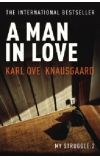
18 Apr 2013 02:35:48
A Man in Love is the second of the six large volumes; the first, A Death in the Family, was published last year. That title (Mein Kampf in German) is often seen as a dark kind of provocation in itself: the size and scale of the undertaking is another. In the latter case, the author has taken Proust as his model, and it is interesting to note that while length in Proust is viewed as a challenge, it isn't construed as provocative. On the contrary, the length not just of A la Recherche du Temps Perdu in its entirety, but of the Proustian sentence and, most of all, of the Proustian moment, is regarded as being in some sense therapeutic. Reading Proust, one is almost by definition declaring one's readiness to dispense with the illusion of narrative in one's concept of living. The reattachment of events, through language, to the framework of time is the ambition of the Proustian and the psychotherapeutic process alike. Struggle is, of course, intrinsic to that process, and likewise it would be hard to understand Karl Ove Knausgaard's work without accepting My Struggle as the plain statement it is.
A man in his 30s, married and living in a pleasant city in Norway, with his first novel just published to much acclaim, Knausgaard suffers from an indefinable malaise: his writing feels obstructed and forced, and its motivations uneasily egotistical; his personal and domestic life seem to constrict him while being unarguably the fruit of his own free choices. "Just the thought of fiction, just the thought of a fabricated character in a fabricated plot made me feel nauseous … Wherever you turned you saw fiction. All these millions of paperbacks, hardbacks, DVDs and TV series, they were all about made-up people in a made-up, though realistic, world. And news in the press, TV news and radio news had exactly the same format, documentaries had the same format, they were also stories, and it made no difference whether what they told had actually happened or not. It was a crisis, I felt it in every fibre of my body, something saturating was spreading through my consciousness … because the nucleus of all this fiction, whether true or not, was verisimilitude and the distance it held to reality was constant."
This crisis, which is the crisis of narrative's distance from reality, is artistic certainly and cultural probably: but Knausgaard's great accomplishment is to show it, pre-eminently, as personal. The indefinable malaise will be defined, but in order to do so, time has to be readmitted into narrative; and one consequence of this is that the vessel of narrative breaks. Knausgaard leaves his home and marriage, gets on an overnight train to Sweden, and arrives in Stockholm in a state of physical and spiritual breakdown. The events that follow this flight from his own life – including the path by which he came upon a new kind of writing and began the enterprise of My Struggle – are the subject of A Man in Love; and there is much to admire in Knausgaard's interrogation and, eventually, sacrifice of his own artistic ego, for it frees him to tackle the problems of living as inextricable from the problems of writing. His refusal to protect the mystique and prestige of his own creativity is in fact far more courageous than his refusal, famously, to protect his own privacy, or that of the people among whom he lived. Instead, he assumes the central role in what becomes a drama of consciousness in action, as the artist struggles to give a new and complete expression to his interior life in step with his life in the world.
What unfolds is a painstakingly detailed account of mid-life, as Knausgaard documents his meeting and relationship with a new partner in Stockholm, their progress into marriage and parenthood, their construction of domestic space and social life, the evolution of their familial relationships and the changing politics of their own bond. These are the universal themes from which My Struggle draws its abundance, and since there is no narrative requirement to attenuate them, Knausgaard finds himself in the position of being able to write about modern middle-class private life with a compendiousness and precision that are entirely singular and new. His writing about domesticity and childcare, in particular, is of a rare and ruthless character: the book opens with a long description of the couple's attempt to take their three small children on a week's summer holiday, at the end of which they find themselves in a decrepit roadside amusement park, barely speaking and being bitten by horseflies. Back in Stockholm, he describes the round of parks and playgrounds, of nurseries and school-gate socialising that is the lot of the modern parent; he captures carefully and lyrically the changing landscape of days spent at the heart of a family, its heavy skies and sudden balminess, its differing terrains, some so featureless and dull and others so challenging, its volcanic love and anger and frustration. And yet, crucially, "Everyday life, with its duties and routines, was something I endured, not a thing I enjoyed, nor something that was meaningful or made me happy … I always longed to be away from it, and always had done. So the life I led was not my own. I tried to make it mine, this was my struggle, because of course I wanted it, but I failed, the longing for something else undermined all my efforts."

